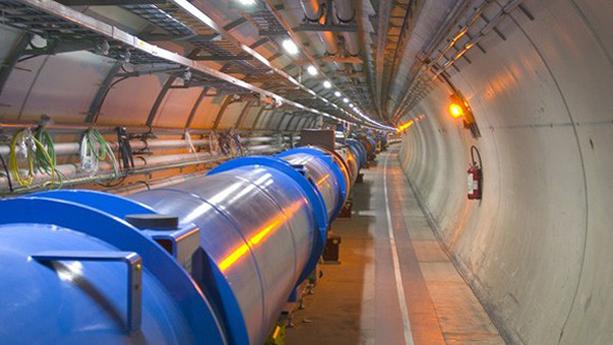universe
Latest

Galaxy studies show that the universe is slowly dying
Not to bum you out, but many scientists believe that the universe will eventually die -- stars and even black holes will release energy until there's virtually nothing left. And unfortunately, there's now stronger evidence that this inexorable decline is real. Scientists using radio telescopes have measured the energy output of 200,000 galaxies with greater precision than ever, and they've determined that these star havens are only producing half as much energy as they were 2 billion years ago. In short, the universe is fading out. This isn't surprising (entropy is inescapable in our understanding of physics), but it does downplay theories that the universe might maintain or even regain energy.

See Neil deGrasse Tyson explain the universe in 8 minutes
Need proof that Neil deGrasse Tyson has a knack for explaining complex astrophysical concepts in simple terms? You don't have to spend the better part of an hour watching a Cosmos episode -- in fact, a short work break will do the trick. The famed astrophysicist has posted a video explaining the basic history of the universe within 8 minutes, ranging from the Big Bang to humanity itself. The clip notes that many things we take for granted (such as gravity and the prevalence of matter) were decided in the earliest moments of the universe, and that our Solar System largely exists thanks to giant stars ejecting heavy elements. That sounds like a lot to take in, but don't worry: this is quite accessible, and it's a good primer on the nature of... well, everything.

Radio telescope array could unlock the secrets of the early universe
To capture the night sky and better understand the formative years of our universe, astronomers are using something a tad more powerful than a traditional telescope. The Owens Valley Long Wavelength Array (OV-LWA) leverages 250 radio antennas, spread over a desert area equivalent to 450 football fields, to detect slender radio signals produced by distant pulsars, solar flares and auroras. Together, this army of antennas can capture the entire sky simultaneously and feed the resulting data back to the Owens Valley Radio Observatory. With over 25 terabytes flowing in every day, astronomers can study space weather, such as auroras, which occur when stars release magnetic energy.

Supernovae suggest the universe is growing slower than expected
Don't look now, but what you know about the universe's growth might have been turned on its ear. University of Arizona scientists have learned that a certain type of supernova (Ia) isn't the reliable measuring stick for universe expansion that previous data would suggest. By comparing optical and ultraviolet images (such as in the hybrid image you see above), they found that older, farther exploding stars aren't behaving in the same way as newer ones closer to our own star. In other words, the ancient supernovae aren't necessarily as distant as you'd think -- and if they aren't, the universe isn't growing as quickly as textbooks say.

New telescope will be a high-resolution window to the universe
That 3D rendering up there is a new telescope from the National Science Foundation that promises to solve the mysteries of the universe -- or at least take some truly big pictures. Fitted with a 3,200 megapixel camera, the Large Synoptic Survey Telescope will be the largest digital camera in the world. Once operational, it will scan the entire night sky a few times a week for ten years and is expected to provide scientists unprecedented access to previously inscrutable parts of the cosmos. The camera will literally shed light on dark energy that is believed to accelerate the expansion of the universe, but has long evaded definitive probes. Apart from capturing images of exploding supernovae at an unfathomable distance, it can detect and track asteroids in our planet's vicinity.

The Big Picture: measuring the 'Eye of Sauron' galaxy
The galaxy you see here (NGC 4151) may be best-known for looking a bit like the Eye of Sauron in the Lord of the Rings movies, but it's now much more important than that -- it may be the key to mapping the universe. Researchers at the Univerity of Southampton have developed a measurement technique that helped them gauge the distance of NGC 4151 (and possibly other galaxies) with greater precision than any previous method would allow. Instead of using the light from other galaxies as a rough yardstick, the team compared the physical size of the dust ring around NGC 4151's black hole against the apparent size taken from infrared readings. These relatively concrete pieces of information helped them narrow down the distance of the galaxy from a very broad range of 4 to 29 megaparsecs to 19, or about 62 million light years; even with 10 percent uncertainty, that's a vast improvement.

A 3D slice of the universe 10.8 billion years ago
Mapping out the ancient universe is a major astronomical goal, but there's a huge challenge: the galaxies there are so dim, scientists can't make out any of the dark parts. But researchers from the Max Planck Institute and US Berkeley/Berkeley Lab have made a breakthrough that may help. They turned their telescopes on a small, 10.8 billion year old chunk of the universe, measuring the change in light from galaxies caused by hydrogen clouds just in front of them. By observing a number of such galaxies, the astronomers created a map of the cosmic web of gases in front of them, in a similar way that scientists map out the brain using CT scans. Though they covered just a tiny portion of the universe, the scientists think it could help the DESI project, due to come online in 2018. It's goal is nothing less than completely mapping the universe to a distance of 10 billion light years.

Cosmic dust definitely clouded Big Bang researchers' findings
Earlier this year, researchers at the Harvard-Smithsonian Center for Astrophysics and the BICEP2 telescope in Antarctica were thought to have found evidence of gravitational waves produced during the first moments of the big bang. The discovery was heralded as one of the most important discoveries of our era -- unfortunately, the results were contaminated. While going through peer-review, astronomers began to wonder if cosmic dust may have skewed the results. Now the verdict is in: it did, but that doesn't necessarily mean the theory is false.

The Higgs boson could destroy the universe in the wrong conditions
That Higgs boson that everyone was so eager to find last year? As it turns out, it could be the end of everything -- in the wrong circumstances, anyway. In his upcoming book Starmus, Stephen Hawking notes that the once-elusive particle could become less than perfectly stable at energy levels of 100 billion giga-electronvolts or higher. If it gets to that state, it could trigger a vacuum bubble that would expand at the speed of light, eventually collapsing all space and time; you wouldn't even know the disaster was coming if the event happened on Earth.

It takes billions of years to see all of No Man's Sky
The universe is a pretty big place, and No Man's Sky's development team wants to replicate its span as best as it can. It's ambitions were grand enough for Hello Games' Sean Murray to say that the universe in No Man's Sky is "infinite" when it was revealed for PS4 at E3 in June. Of course, the game isn't really "infinite," and Hello Games is fully aware of that, and ultimately wants the game to "surprise" players. The developer addressed that late last week with IGN, discussing its previous use of a 32-bit number to automatically generate the planets in the game. "With that 32-bit number it would take you four or five thousand years to see every planet if you spent only a second on each one," it said. See? Not infinite. However, the developer noted that it is now using a 64-bit number to procedurally produce No Man's Sky's universe, which means it will take roughly five billion years to see each planet in the game. The still-not-infinite-but-rather-huge universe of No Man's Sky will arrive on PC after it launches on PS4, though it's unknown just when that will be. [Image: Hello Games]

Big Bang researchers aren't so sure they have proof of cosmic ripples
Remember that evidence of the early gravitational waves formed by the Big Bang? Apparently, it's not as surefire as scientists once thought. The newly peer-reviewed findings note that there's "unquantifiable uncertainty" in the source data; cosmic dust in the astronomers' map of the universe may have skewed the results. More recent mapping efforts also suggest that there might have been a false signal.

Engadget Daily: a guide to Japanese toilets, Apple eyes Beats for $3.2 billion and more!
You might say the day is never really done in consumer technology news. Your workday, however, hopefully draws to a close at some point. This is the Daily Roundup on Engadget, a quick peek back at the top headlines for the past 24 hours -- all handpicked by the editors here at the site. Click on through the break, and enjoy.

The 13 billion-year evolution of the universe, crammed into a four-minute video
Now you've got the basics of the universe down, try a dreamy tour through 13 billion years of stars and the space between them all. That's what Nature's offering, courtesy of MIT and the Harvard-Smithsonian Center for Astrophysics. Prior attempts to scale and visualize everything ever were apparently hampered by a lack of computing processing power and the outright trickiness of the physics involved. The Illustris Project eventually took five years to craft and is apparently made of 10 billion minute cubes inside a virtual box measuring some 350 x 350 million light-years. It's not the first history of everything simulation, but it's the fanciest looking one -- watch the whole thing after the break. Astronomer Michael Boylan-Kolchin adds, in a commentary of the study: "If this all sounds somewhat complicated, do not be fooled: It is extremely complicated."

EVE Evolved: Designing EVE Onland, part 2
When it comes to living sandbox MMOs, there really isn't a bigger name than EVE Online. Throughout its decade-long history, EVE has produced some huge gaming headlines, delivered record-breaking in-game thefts and heists, and played host to the complex political machinations of dozens of warring alliances. EVE's sandbox design has even made it remarkably resistant to changes in the market, with subscription numbers remaining relatively stable in the face of new releases and the free to play phenomenon. It comes as no surprise then that the sandbox genre is seeing a triple-A revival, with games like Star Citizen, EverQuest Next Landmark, and Camelot Unchained on the way. With the sandbox genre due to explode back onto the fantasy scene, I've been left wondering how much of the core gameplay that makes EVE tick could be easily adapted for an avatar-based game on land. Even features such as EVE Online's trademark territorial warfare and player-run economy have roots in classic fantasy MMOs like Ultima Online, so they should be easy to convert to modern fantasy equivalents. Last week I started this game design thought experiment with a territorial warfare system and free-for-all PvP with harsh consequences for attackers, but there's a lot more to a good sandbox than smashing people's heads in. In this week's EVE Evolved, I delve into the hypothetical world of EVE Onland again and tackle issues of realistic world scale, exploration, economics, and the evils of global banking.

Planck space telescope retires from observing the early universe
After nearly 4.5 years of watching the stars, the Planck telescope is officially out of action. European Space Agency scientists have shut off the observation satellite now that it has both finished its mission and parked in a "permanent hibernation" orbit around the Sun. The telescope accomplished a lot during that short lifespan, however -- by creating a detailed map of cosmic background radiation, Planck gave us a snapshot of the early universe that will help us understand the evolution of space. Researchers still haven't finished studying Planck's findings, which suggests that the spacecraft's legacy will last well beyond the final transmission.

Google and NASA make a short film to explain their quantum computing lab (update: video)
Google and NASA made much ado of their Quantum Artificial Intelligence Lab when it launched in May, but they said little about how it works or its long-term goals. The two organizations are shedding a little more light on the subject through a new short film for the Imagine Films Science Festival. As Google and NASA explain, the lab could ultimately solve optimization problems that are beyond the scope of traditional computers. NASA may develop a more holistic model of the universe, for example, while Google could improve medicine. The film also provides a rare peek at the inside of one of D-Wave's second-generation quantum computers -- despite the small size of the circuitry, each system needs a giant enclosure that cools the hardware down to near absolute zero. The film is available to watch through The Verge, but those who want to check out the official screening can pay for a $50 festival pass and visit Google's New York City campus on October 11th at 7PM. Update: The short film is now embedded after the break for your viewing pleasure.

Scientists calculate the speed of free-roaming dark matter
When dark matter is the most pervasive substance in the universe, it's important that we know how quickly it can move. Thankfully, Syracuse University scientists may have just found that speed. By comparing distribution in the early universe with what we see today, researchers now estimate that free-roaming dark matter moves at 54 meters per second (177 feet per second). That's pokey in relation to other materials in space, and the calculation assumes that nothing gets in the way -- most dark matter is stuck in clumps. The number may not sound like much, but it could be vital to physicists wanting to test (and possibly prove) their theories about a very mysterious element. [Image credit: NASA]

Eidos' Deus Ex: Universe is an 'expanding and connected' world that spans platforms and titles
Eidos Montreal has seen the future for its Deus Ex franchise and it's ready to shed some light on its connected vision. On the company's community blog, studio head David Anfossi revealed that the next phase for the franchise builds upon lessons learned from Deus Ex: Human Revolution; something Eidos Montreal is calling Deus Ex: Universe. No, it's not a standalone title for the next-gen, but rather a new, unifying approach to "create an ongoing, expanding and connected game world" that spans all upcoming titles. And that's cross-platform, too, as this persistent world and the additional experiences it'll deliver will encompass traditional platforms like the PC and console, as well as the portable space, mobile and even graphic novels. Work's apparently already underway on the project, with the first title in this new Universe slated to hit the PC and next-gen console space.

Hawaii clears land use for the Thirty Meter Telescope, construction to start in 2014
The Thirty Meter Telescope has been under development for more than a decade, but the sheer amount of land needed on Hawaii's Mauna Kea for its namesake main mirror has proved problematic: locals have formally challenged the multi-university effort over concerns that it might damage both the environment and natives' heritage. Regardless of which stance you take on the issue, the project is going forward now that the state's Board of Land and Natural Resources has granted an official land permit. The move clears an optical and near-infrared telescope with nine times the coverage area of its peers, and three times the sharpness. That's enough to observe light from 13 billion years ago as well as put a heavy focus on tracking extrasolar planets, including planets in the making. Any impact on science or Mauna Kea will have to wait when construction doesn't even start until April 2014, although we're hoping that environmental care requirements attached to the permit will let us appreciate both the early universe and modern-day Earth in equal measure.

BioWare Edmonton and producer Casey Hudson working on 'a whole new fictional universe'
During a panel this weekend at PAX East, Mass Effect producer Casey Hudson revealed that his team at BioWare Edmonton has started work on "a whole new fictional universe." Other details weren't shared, except that Hudson said that he and BioWare's Senior Creative Director Preston Watamaniuk are going to be "building something new" together.Hudson oversaw Mass Effect 3 as an executive producer, and he says he'll still serve that role on the next Mass Effect title. But that game is being developed at BioWare Montreal, so Hudson's team at BioWare Edmonton has moved on to something completely new. Hopefully we'll hear more about it soon.










